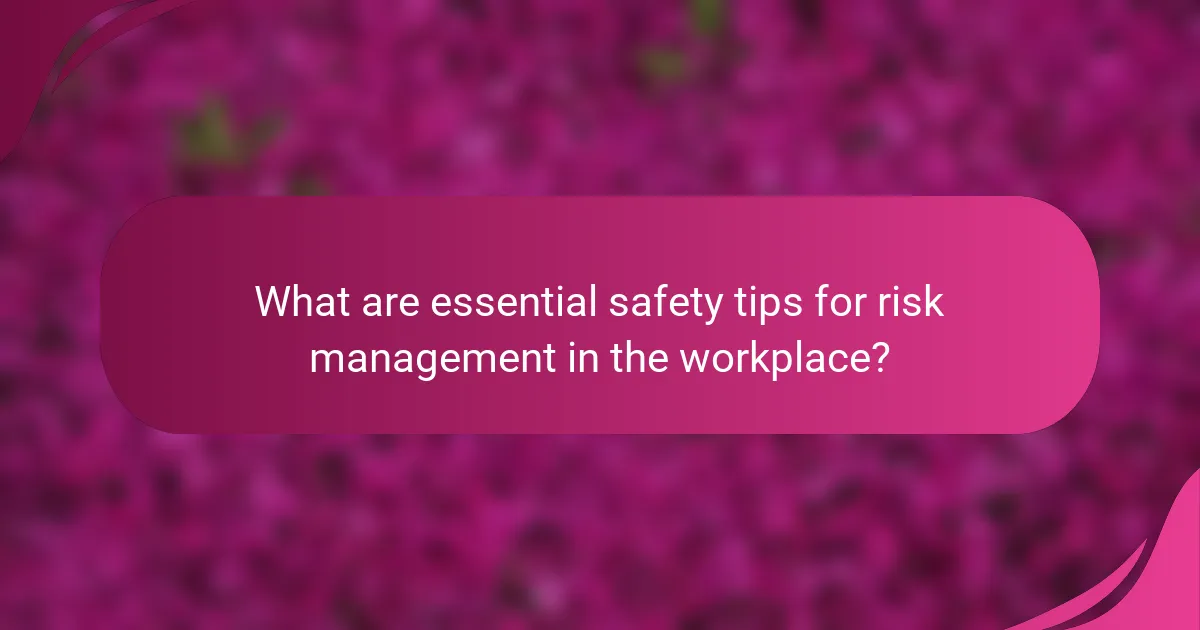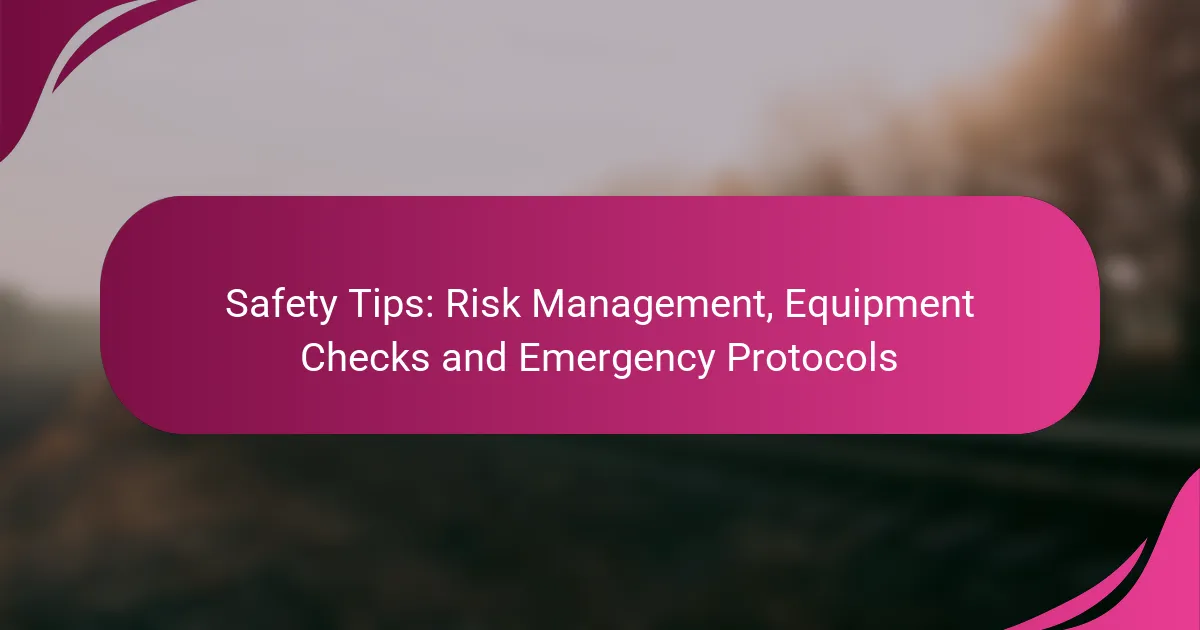Ensuring safety in the workplace is crucial for risk management and involves regular assessments, employee training, and a strong safety culture. Conducting systematic equipment checks is essential to identify potential issues early, enhancing both safety and operational efficiency. Additionally, well-defined emergency protocols are vital for effective responses during unexpected situations, safeguarding lives and minimizing risks.

What are essential safety tips for risk management in the workplace?
Essential safety tips for risk management in the workplace include conducting regular assessments, implementing training programs, and fostering a safety culture. These practices help identify hazards, educate employees, and create an environment where safety is prioritized.
Conduct regular risk assessments
Regular risk assessments are crucial for identifying potential hazards in the workplace. This process involves systematically evaluating tasks, equipment, and environments to pinpoint risks and prioritize them based on severity and likelihood.
Consider conducting assessments at least annually or whenever there are significant changes in operations, such as new equipment or processes. Utilize a checklist to ensure all areas are covered, and involve employees who are familiar with the tasks being evaluated.
Implement safety training programs
Safety training programs equip employees with the knowledge and skills to recognize and mitigate risks. These programs should cover emergency procedures, proper equipment use, and hazard recognition.
Training should be conducted regularly, with refreshers at least once a year. Tailor the content to specific roles and include hands-on practice to reinforce learning. Consider using a mix of in-person and online training methods to accommodate different learning styles.
Establish a safety culture
A strong safety culture encourages employees to prioritize safety in their daily activities. This can be fostered by leadership commitment, open communication, and recognition of safe practices.
Encourage employees to report hazards without fear of reprisal and actively involve them in safety initiatives. Regularly celebrate safety milestones and achievements to reinforce the importance of a safe work environment.
Utilize safety checklists
Safety checklists are practical tools for ensuring compliance with safety protocols. They can be used for daily equipment checks, pre-operation inspections, and during training sessions.
Develop checklists that are specific to tasks or equipment and ensure they are easily accessible to all employees. Regularly review and update these checklists to reflect any changes in procedures or regulations.
Engage employees in safety discussions
Engaging employees in safety discussions fosters a collaborative approach to risk management. Regular meetings or safety briefings can provide a platform for sharing concerns, suggestions, and best practices.
Encourage open dialogue by creating a safe space for employees to voice their opinions. Consider implementing a suggestion box or regular surveys to gather feedback on safety issues and improvements.

How to perform effective equipment checks?
Effective equipment checks involve systematic evaluations to ensure safety and functionality. Regular inspections help identify potential issues before they become serious problems, thereby reducing risks and enhancing operational efficiency.
Follow manufacturer guidelines
Adhering to manufacturer guidelines is crucial for safe equipment operation. These guidelines provide specific instructions on how to operate, maintain, and inspect equipment properly, ensuring compliance with safety standards.
Always refer to the user manual for detailed procedures and recommendations. This includes information on recommended inspection intervals, which can vary significantly between different types of equipment.
Schedule routine maintenance
Routine maintenance is essential for prolonging the life of equipment and preventing unexpected failures. Establish a maintenance schedule based on usage frequency and manufacturer recommendations, typically ranging from weekly to monthly checks.
Incorporate tasks such as lubrication, part replacements, and software updates into your maintenance routine. Keeping a calendar or digital reminder can help ensure that these tasks are not overlooked.
Document equipment inspections
Documenting equipment inspections is vital for tracking performance and compliance. Maintain a log that records inspection dates, findings, and any actions taken to address issues.
This documentation not only helps in identifying recurring problems but also serves as a reference for audits and regulatory compliance. Consider using digital tools for easier access and management of inspection records.
Use checklists for equipment safety
Checklists are effective tools for ensuring thorough equipment inspections. Create a checklist that includes all critical safety and operational aspects to evaluate during each inspection.
Common items to include are visual inspections, functionality tests, and safety feature checks. Utilizing a checklist can help prevent oversight and ensure that all necessary steps are followed consistently.

What are the emergency protocols to follow?
Emergency protocols are structured procedures designed to ensure safety during unexpected situations. These protocols help organizations respond effectively to emergencies, minimizing risks and protecting lives.
Develop a clear emergency action plan
An emergency action plan outlines the specific steps to take during various emergencies, such as fires, natural disasters, or medical incidents. This plan should include evacuation routes, designated assembly points, and responsibilities for key personnel.
Ensure the plan is accessible to all employees and regularly reviewed. Consider using visual aids, like maps or flowcharts, to enhance understanding and retention of the procedures.
Conduct regular emergency drills
Regular emergency drills are crucial for familiarizing employees with the action plan. These drills should simulate real-life scenarios to test the effectiveness of the protocols and identify areas for improvement.
Schedule drills at least twice a year, varying the scenarios to cover different types of emergencies. After each drill, gather feedback to refine the action plan and address any weaknesses observed during the exercise.
Establish communication channels
Effective communication is vital during emergencies. Establish clear channels for disseminating information, such as alarms, intercom systems, or mobile alerts, to ensure everyone is informed promptly.
Consider designating a spokesperson to relay information to employees and external agencies. Regularly test these communication systems to ensure they function correctly when needed.
Train employees on emergency procedures
Training employees on emergency procedures is essential for a quick and effective response. Conduct training sessions that cover the action plan, roles, and responsibilities during an emergency.
Utilize a mix of training methods, including hands-on practice, workshops, and online modules. Ensure that all employees, including new hires, receive this training and refresh their knowledge periodically to maintain preparedness.

What criteria should be used for selecting safety equipment?
When selecting safety equipment, prioritize effectiveness, compliance with regulations, and user comfort. These criteria ensure that the equipment not only protects workers but also meets legal standards and is practical for daily use.
Assess specific workplace hazards
Identifying the specific hazards present in your workplace is crucial for selecting appropriate safety equipment. Conduct a thorough risk assessment to determine potential dangers such as chemical exposure, machinery risks, or fall hazards. For instance, if working at heights, fall protection gear like harnesses and lanyards is essential.
Consider the frequency and severity of these hazards. Equipment should be chosen based on the likelihood of exposure and the potential consequences of accidents. This targeted approach helps in investing in the most effective safety measures.
Evaluate compliance with safety standards
Ensure that the safety equipment meets relevant local and international safety standards. In the U.S., for example, equipment should comply with OSHA regulations, while in Europe, CE marking may be required. These standards dictate the minimum safety requirements that equipment must fulfill.
Review certifications and labels on safety gear to confirm compliance. This not only enhances safety but also protects your organization from legal liabilities. Regularly update your knowledge of standards as they can change over time.
Consider user comfort and usability
User comfort and usability are vital for the consistent use of safety equipment. If workers find the gear uncomfortable or cumbersome, they may be less likely to wear it properly or at all. Look for equipment that is lightweight, adjustable, and ergonomically designed.
Conduct trials with employees to gather feedback on different equipment options. This can help identify which products are most effective in real-world conditions. Remember, equipment that is easy to use and comfortable increases compliance and overall safety in the workplace.

How can technology enhance safety protocols?
Technology can significantly enhance safety protocols by streamlining risk management, improving equipment checks, and facilitating emergency responses. By integrating advanced tools and systems, organizations can ensure a safer environment for employees and reduce the likelihood of accidents.
Implement safety management software
Safety management software helps organizations track incidents, manage compliance, and analyze safety data efficiently. These platforms often include features like incident reporting, audit management, and risk assessments, allowing for real-time monitoring and proactive measures.
When selecting safety management software, consider factors such as user-friendliness, integration capabilities with existing systems, and support for regulatory compliance. Popular options include platforms that offer mobile access, enabling on-the-go reporting and updates.
Utilize wearable safety devices
Wearable safety devices, such as smart helmets and vests, enhance worker safety by providing real-time data on environmental conditions and individual health metrics. These devices can alert users to potential hazards, monitor vital signs, and even track location for emergency response purposes.
When implementing wearable technology, ensure that devices are comfortable and suitable for the specific work environment. Consider factors like battery life, durability, and data privacy to maximize effectiveness and user acceptance. Regularly review the performance and feedback to adapt the technology to evolving safety needs.
